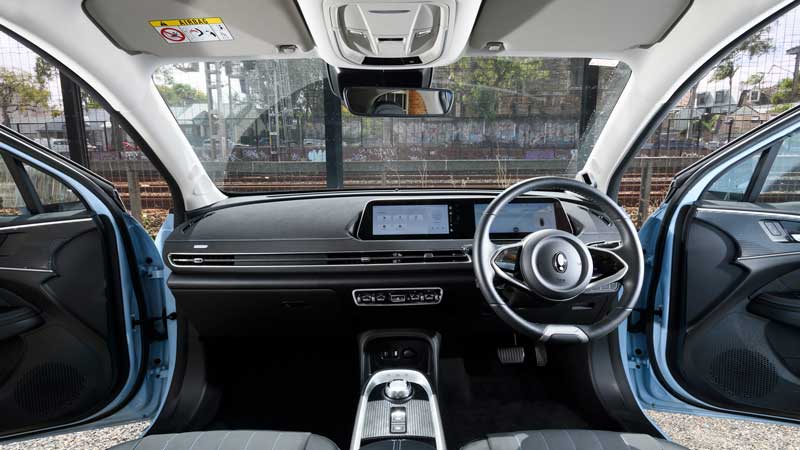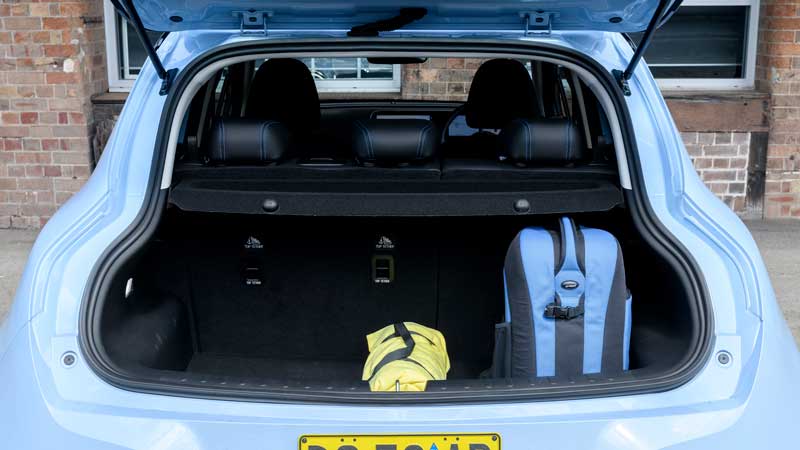

Of the three marques in this comparison MG is the most recognisable, as many older drivers have fond memories of the iconic post-war British sports car. SAIC Motor, China’s largest listed automotive company, bough the nameplate in 2007. MG entered our EV orbit with the MG ZS EV in 2020, one of the most affordable EVs on sale at the time.
Great Wall Motors (GWM) started inauspiciously in Australia in 2009, offering a couple of utes starting under $20k. There wasn’t much to like apart from the price, and a poor two-star ANCAP safety rating sealed their fate. Models from then on became sporadic until 2016, when GWM assumed control of Australian operations. The Ora is the first EV from the brand to go on sale here.
Build Your Dreams (BYD) was founded in 1995, initially manufacturing rechargeable batteries. It’s had skin in the game as an automotive manufacturer since 2003, trading under the BYD Auto moniker, and it’s currently the largest manufacturer of EVs in China. The Atto 3 medium SUV has rocketed up the sales charts since its 2023 debut and BYD currently has 3 EVs in our market.
There’s nothing like a bit of competition to sharpen pricing. The GWM ORA now has a national drive-away price starting at $35,990, while MG has reduced prices across their line-up.

BYD’s sales trajectory has been remarkable given it launched with just one model, the Atto3 SUV, a year ago. That vehicle was a surprise packet and so is the new Dolphin.
The range starts at $38,990 plus on-road costs for the Dynamic, while our test car, the Premium, $44,890, is priced at around $48k after on-roads, making it the most expensive of the trio. The Dynamic uses a 70kW/120Nm electric motor and 44.9kWh battery, while the Premium’s electric motor output climbs to 150kW/310Nm using a larger 60.5kWh battery.
BYD’s expertise lies in battery design, and it has been developing lithium-ion phosphate batteries rather than more expensive nickel cobalt, plus its ‘blade’ technology, where the cells are stacked vertically, purportedly makes the battery more durable and compact.
The standard features list mirrors the Ora’s and MG4’s, with a large panoramic sunroof, heated front seats and rotating 12.8-inch infotainment screen upping the ante slightly. The Dolphin has a six-year, 150,000km vehicle warranty and eight-year, 160,000km battery warranty. Service intervals are 12 months/20,000km, with prices varying from $189 to $447, totalling just under $1400 over five years.
The range has a five-star ANCAP rating with all models receiving a full complement of safety kit including autonomous emergency braking, lane departure prevention, and emergency lane keeping assistance.

The Dolphin’s external design is nicely proportioned and restrained. The interior is where the designers have let their hair down, with a futuristic dash layout front and centre and impossible-to-miss fin-shaped door handles.
You can change up the look by simply rotating the infotainment screen, while the two-tone interior finishes add a touch of class. The fixed headrest front seats wouldn’t be out of place in a hot hatch and, though not heavily bolstered, they rival those in the MG4 for comfort. There’s plenty of leg room in the second row and, as in the MG4, the floor in the cargo area can be dropped to increase cargo space.

The Open Road team much preferred the Dolphin’s conventional stop/start button and rotating gear selector mounted on the side of the centre console and, while a larger instrument display screen would be welcome, the package works nicely.
So too do its on-road manners. It’s not going to outrun the MG4 through the bends and the steering is too light at low speeds, but it’s not going to fall in a screaming heap and the ride quality is on par with the MG4 and Ora.
On paper the Dolphin Premium should have an edge with more power and torque, but over our road test loop it was hard to pick any real advantage. It’s certainly no slouch, however, and under our informal 0-100km/h run it just shaded the other two, albeit with a touch of wheelspin from a standing start.
The Dolphin has a CCS2 charging port, and while charging the trio, we noted the Dolphin reached 90 per cent in a shorter time, and over the remainder of our drive loop recorded 11.6kW/100km.
GWM previewed the Ora in early 2023, and order books opened soon afterwards. Known as the Ora Cat and Funky Cat in other markets, local executives opted to keep it simple and just refer to it as the Ora here.
With prices from $35,990 drive away for the entry-level 310km range the Ora takes the title of cheapest EV on sale in Australia, although our 420km extended range test vehicle comes in at $40,990, with the 420km Ultra $43,990.
The Extended Range uses a 63kWh battery and 126kW/250Nm electric motor driving through the front wheels and connects to a power source via a CCS2 charging port.
Standard features include 10.25-inch multimedia and instrument screens, Apple CarPlay and Android Auto, a six-way electric driver’s seat, faux leather seat facings, wireless phone charging, a 360-degree around view camera, rear parking sensors, and 18-inch alloys.

The Ora has a five-star ANCAP safety rating thanks to seven airbags, autonomous emergency braking with pedestrian, cyclist and crossing detection, and camera-based driver drowsiness detection. All EVs featured here have subtle audible overspeed reminders rather than the louder, in-your-face systems installed on some competitors’ vehicles.
The Ora has a seven-year unlimited kilometre warranty, five years of roadside assistance, and five-year capped-price servicing of $99 (every 12 months or 15,000km).
Looking like a distant relative of Mazda’s cute 121 ‘bubble’ from years past, the Ora certainly raised the interest of passers-by.
If you’re looking for an EV with some personality, the Ora delivers, albeit at the expense of ergonomics. The seating positions are perched unnaturally high and the front seats are the least comfortable of this trio, lacking lower back support. Care is needed when exiting the second row, as the tapered roof pillar restricts egress somewhat.
Opening the rear hatch reveals a deep cargo space with a high load lip, vying with the Dolphin for the smallest cargo area. The second row doesn’t fold flat into the floor, either, reducing practicality. Unlike their larger EV cousins, none of this trio has additional cargo area under the ‘frunk’ or bonnet.

The Ora’s build quality and overall interior presentation rival the Dolphin’s, with the twin screens a highlight, and it outpointed the more austere MG4’s presentation. Managing vehicle functions via the touchscreen presents challenges in all three cars.
The Ora and Dolphin didn’t trouble the rear-wheel-drive MG through the bends, but it’s worth remembering these EVs will primarily be urban dwellers, where ride quality, and light steering are the priorities – and to that end the Ora is up to the task. Performance from the 126kW electric motor is measured and 250Nm from the get-go helps.
Our seat-of-the-pants 0-100km/h acceleration comparison revealed little difference between the Ora and MG4. The Ora’s one-pedal drive setup works seamlessly and isn’t overly aggressive. Heading off on the second leg of our road test loop with 90 per cent charge and an indicated range of 349km, the Ora used 15.1kW/100km for the rest of the journey.
Launched mid-2023, MG’s first dedicated EV is proving popular with consumers, moving into third position in its model line-up after the bargain-basement MG3 hatch and ZS SUV range. While SAIC is just as unfamiliar as GWM and BYD here, attaching the MG nameplate to its range of passenger vehicles has been a shrewd move, arguably damping buyer reservation.
MG has taken a scalpel to the price list since launch, offering drive-away pricing starting at $39,990 for the 51kWh Excite. There’s a lot to unravel, with four specification levels, three battery capacities, and three electric motor outputs available, plus the new X-Power dual motor. All models use a CCS2 charging port.
Our test car was the 150kW/250Nm 64kWh Essence priced at $46,990 drive-away. MG offers a seven-year/unlimited warranty and capped price servicing (which for EV models is at 24-month/40,000km intervals and alternates between $296 and $907).
Standard fare includes a 10.25-inch infotainment screen and seven-inch digital instrument display, Apple CarPlay/Android Auto, satellite navigation, six-speaker audio, six-way electric driver’s seat, 18-inch wheels, a two-level boot floor, and 360-degree camera.
The range has a five-star ANCAP rating, with Essence versions fitted with additional blind spot protection, rear cross traffic alert, emergency lane keeping assistance, and lane change assistance. Visually the MG4 is the polar opposite of the Ora – sharp and angular versus organic – with the Dolphin splitting the two.
The MG4 looks more like a hot hatch, with one of our team comparing it to a stumpier version of Toyota’s sporty 86 GT when seen front-on. There are practical benefits to the design and under the wide opening rear hatch lurks 363 litres of cargo volume, increasing to 1165 litres with the second-row seats folded, plus the added advantage of the dual floor.

Opening the front door reveals an interior that lacks pizazz, with a smattering of contrasting satin finishes trying in vain to inject some life into an otherwise drab design. The small instrument cluster is framed by an oversized thick-rimmed D-shaped steering wheel and a rotary dial gear selector sits on a tray protruding from the dash, providing a home for phones. Below, a shallow tray with sliding cover delivers additional storage.

The MG4 was more accomplished over our drive loop than the Ora and Dolphin. It has a better tyre footprint, using 235/48X18 Bridgestones to good effect, and it felt more planted through the twists and turns, especially when the road surface varied.
Drive is via the rear wheels, which will please purists, and there’s a myriad of drive modes to fiddle with including one-pedal drive. There were a few niggles – the tyre pressure monitoring system would alert to check the same tyre constantly even though pressure was the same as the others and the rotary dial gear selector often required a couple of firm applications of the brake pedal before it would shift into gear.
Charged to 90 per cent, the MG4 showed an indicated range of 424km and used 14.1kW/100kmh for the rest of the test.
Reviewing a trio of EVs exclusively from Chinese manufacturers was a first for Open Road. They’re far from perfect and all three have infotainment and vehicle settings functions which test one’s patience (and if I hear another ‘welcome back’ announcement anytime soon I’ll scream).
The Ora is currently the cheapest EV in our market and a viable alternative to a petrol hatch.
The MG4 is the pick if driving engagement is paramount, and the Dolphin, although the most expensive, felt the most complete package. Its ability to charge to 90 per cent the quickest tipped this comparison in its favour.
|
GWM Ora Extended Range |
BYD Dolphin Premium |
MG4 64Essence |
|
|
Engine |
Single electric motor (FWD) |
Single electric motor (FWD) |
Single electric motor (RWD) |
|
Battery |
63kWh lithium-ion |
60.5kWh lithium-ion |
64kWh lithium-ion |
|
Power |
126kW |
150kW |
150kW |
|
Torque |
250Nm |
310Nm |
250Nm |
|
Range |
420km |
427km |
435km |
|
ANCAP |
Five stars |
Five stars |
Five stars |
|
Spare wheel: |
Inflator kit |
Inflator kit |
Inflator kit |
|
Price |
$40,900 (drive away) |
$44,890 (plus ORC) |
$46,990 (drive away) |